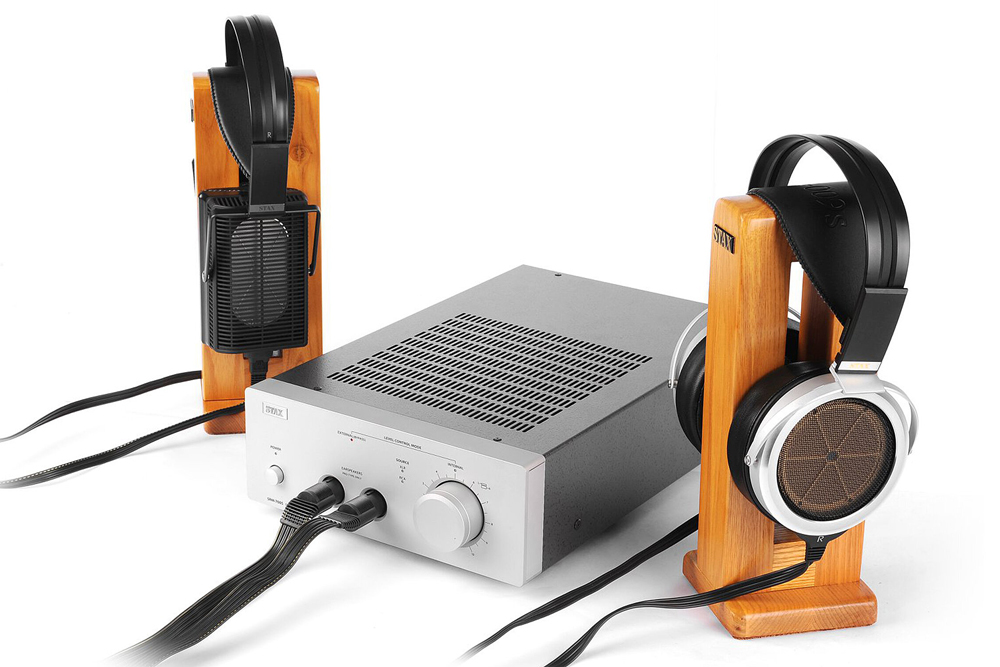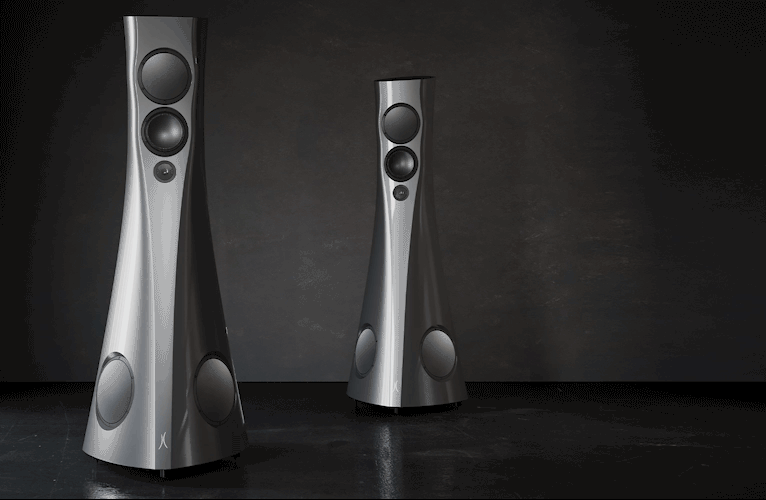If I had one Hi-Fi story to pass on to the new generations, it would go something like this: “Dear young people, we live in a world full of magical devices. They let us do wonderful things and if our grand-grand-grandparents saw us they’d think we’re all wizards. But looks can be deceptive. Long ago people could only listen to the music with their own ears, but although these days we can play any song, sonata or symphony by just tapping on a screen, the real sound of a guitar, violin or any other instrument is a mystery to many of us. We hear reproduced approximation of the sound and we’re happy with it. We seldom hear “the real thing”, live and vibrant! The best example of this are the headphones you use. There are so many of them… earbuds, over-the-ear, wireless, noise-cancelling, what have you. Some are cheap, some cost quite a bit, some sound nice, some sound better, some are ugly, some look good… but 99% of them are not even close to the real thing!
And still I would continue: “If you think I’ve gone mad or if you’d like to find out what I’m talking about, please walk into any hi-fi shop that sells electrostatic headphones and ask for a demo. After you’ve heard them, and if you’re really passionate about your music, you will scramble and scrounge every last coin you have, buy a pair of electrostatic headphones and live happily ever after.”
The sad alternative would be that we allow yet another generation to grow up listening to the sound quality equivalent to a blow-up doll…
For the lovers of the real thing
Electrostatic headphones are the most accurate way of sound reproduction you can have. When you put them on your head, the first thing you’ll notice is that they’re very light. Instead of magnets and coils of wire, their only moving part are microns-thin, incredibly light membranes that move between two grilles. That’s all. Simplicity itself. No heavy parts that muffle the sound. No funny-shaped surfaces that distort it. The catch is (yes, there’s always a catch) that electrostatic headphones don’t come cheap and they don’t come alone. You need a special amplifier to drive them. You can’t just plug them directly into your iPhone or DAC because a) the voltages and currents are different to your usual electrodynamic headphones, and b) the connector is VERY different.
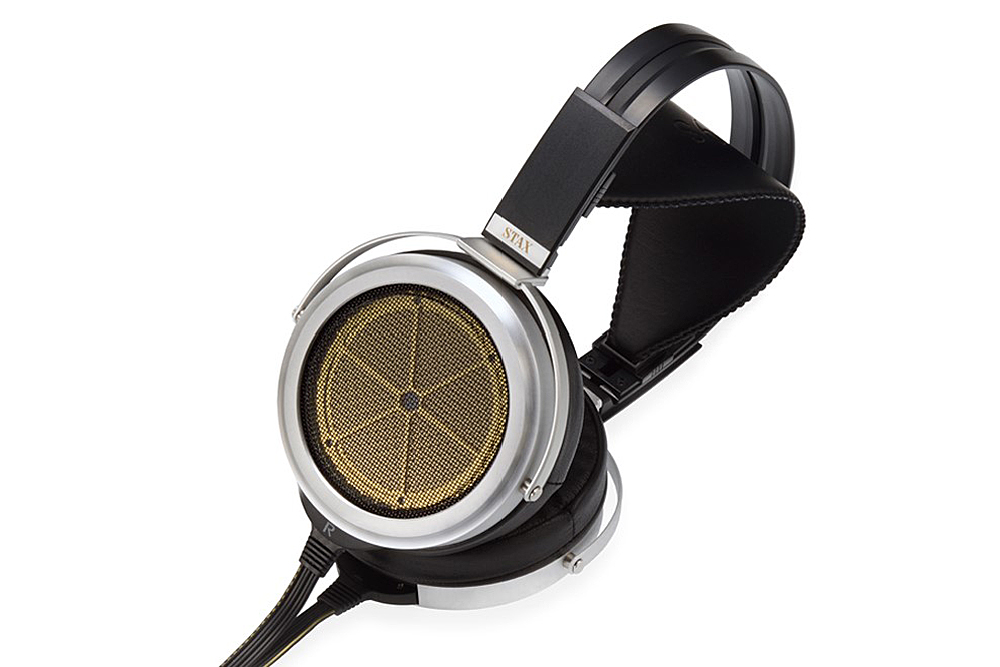
If you do a search for “electrostatic headphones” you’ll find a wealth of such headphones and accompanying amplifiers on the market. Out of the models you’re likely to see, a fair proportion will probably come from the Japanese company Stax. Stax have been making electrostatic headphones since the 1950s and they’re a legend in this field. As with any Hi-Fi company, and especially the ones that operate on the bleeding edges of the possible, Stax has seen peaks and troughs in achievements but they all reside within dizzying heights of the electrostatic sound reproduction. Beyond the ordinary and even extraordinary efforts of other technologies. Stax’s latest accomplishment (and in my view a very prominent one) is the SRM-700S electrostatic headphone amplifier. Coupled with high-quality electrostatic headphones, this amplifier can be rightfully regarded as “for the lovers of the real thing”.
Before we get to the amplifier itself, I’d better tell you more about the headphones I’ve been using it with. For the purpose of this review, sent here was a pair of Stax SR-009S (AU$7750) headphones, which is the current top model in the Stax stable. I utilised them extensively in my listening tests, as well as my own pair of Stax SR-507, which are considered a mid-level model. Unsurprisingly, SR-009S proved to be more detailed, and their sound was more spacious and airy, but I was quite happy to find out that my SR-507 were not far behind, especially when you take into consideration the price difference. Most of the time both pairs of headphones were plugged into the amplifier, changing them often on my head in order to figure out whether any particular listening impression was due either to headphones or the amplifier itself. The result is my best humanly possible estimation of the amplifier’s capabilities with all other factors (i.e. headphones) taken into account.
Features
Stax SRM-700S is designed to do one thing only and to do it well: to amplify the signal from its input. It does not come with a DAC, it has no tone controls and no flashy indicators and lights that adorn so many devices nowadays. It does come, however, with both XLR and RCA inputs, XLR being particularly welcome to minimise any hum or interference that ultra-sensitive electrostatic headphones tend to reveal whenever the input signal path or grounding are not ideal. Both kinds of inputs are at the back of the unit, together with an XLR/RCA selector and a switch that allows you to bypass the volume control in case you prefer to control the volume externally. A handy feature is the set of RCA outputs (‘Parallel Out’/pass-through) that allow you to insert the amplifier into an input circuit of your Hi-Fi system without requiring an external splitter. Lastly, there is a grounding post. I did not use it because my system is already earthed elsewhere and I did not want to create any ground loops, but you might have a different situation or preference.
The SRM-700S features a dual-FET in the amplification’s first stage while, for the first time in Stax’s history, the engineers have adopted a J-FET second stage. The J-FET stage is said to be extremely low in overall noise and is combined with a “large current emitter follower circuit” in order to bring out a stated full performance of electrostatic headphones, even those with tricky impedance plots in the high frequency range. The SRM-700S impedance specifications are quoted as 50kohm (RCA), 50kohm by 2 (XLR), with gain being 60dB and the frequency response spans from DC to 100kHz when using one set of Stax’s own SR-009S headphones. It’s worth mentioning here that Stax also offer the SRM-700T headphone amplifier which is a valve-based version for those seeking an alternative tonal take.
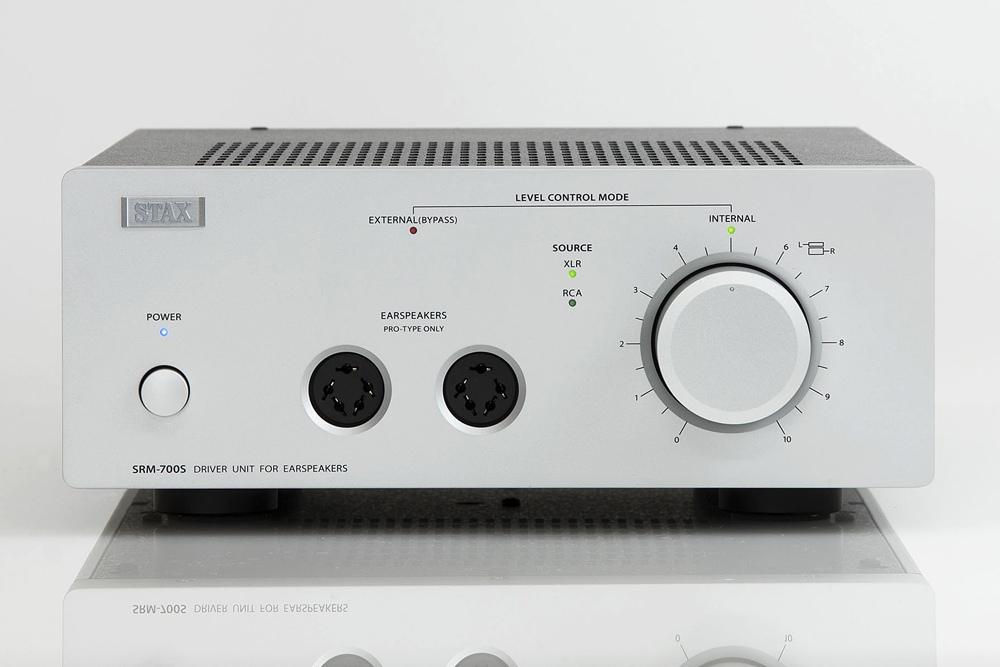
The front of the amplifier is neat and tidy, with one prominent knob (Volume/Balance), a power switch and two large 5-pin output connectors (Pro bias type ), plus indicators that show whether the input signal is coming from RCA or XLR, whether the volume control has been bypassed and if the unit is on.
The amplifier is the size of a large shoebox (well, we’re probably talking about boots here: 24cm wide, 40cm deep and 10.5cm high, keeping in mind that you’ll also need extra space for the cooling airflow) and should fit neatly on a typical shelf where Hi-Fi gear usually resides. Its weight of slightly more than 6kg is due in no small measure to the traditional transformer-based power supply, as well as heatsinks which are all internal, so you don’t see any fins protruding anywhere. The amplifier is solid-state and analogue. No digital processing anywhere, no chopping, no smoothing, just pure analogue linear amplification.
Listening Impressions
The SRM-700S has huge amplification and very low noise, which provides an ample dynamic range for even the most challenging music passages. It effortlessly picked up the pianissimo intro in any rendition/version of Ravel’s “Bolero”, even the faintest ones, and even on the second take after I had to turn the volume down a bit during the thunderous final crescendo. A case in point would be the version recorded in 1975 by Boston Symphony Orchestra, with Seiji Ozawa at the helm (Deutsche Grammophon 478 3386). For relatively quieter music like jazz and chamber orchestras I kept the volume knob around 12 o’clock, while for louder and/or more dynamic pieces it typically stayed around 10 o’clock. The amount of amplification is such that by the time you twist the knob to 2-3 o’clock you’re going deaf fast, unless your sound source is of a less vigorous nature than usual. Talking about the volume, beware: the sound of electrostatic headphones is so detailed that it can easily “draw you in” and all of a sudden you can find yourself increasing the volume in order to hear additional details that are delivered in their full glory and with no distortion. In the end, you might end up answering people’s questions with “What?”…
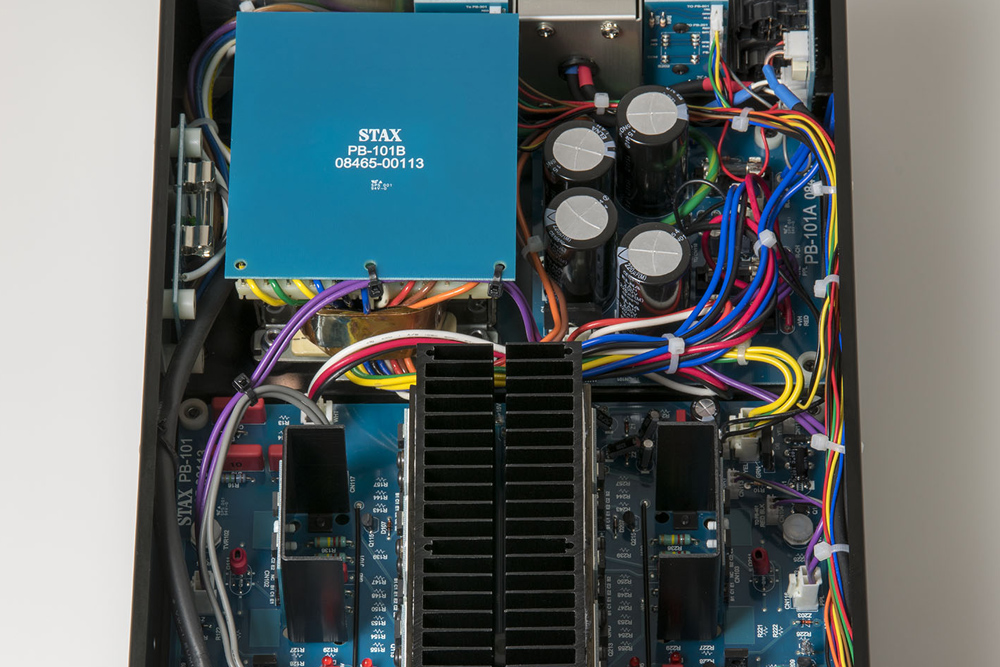
SRM-700S reproduces vibrant, accurate high frequencies devoid of even a trace of shrillness. My reference recording for treble (“Jupiter” from Holst: The Planets by Boston Symphony Orchestra, conductor William Steinberg) came through with such clarity that it was very hard to keep the necessary analytical composure and not to slide into complete ecstasy. With Stax SR-009S headphones the treble was crystal and superb in every way, while my SR-507s delivered the highest notes just slightly subdued, although “disciplined” might be a more appropriate word. In any case, it was obvious that the amplifier is more than capable of delivering what’s required.
SRM-700S’ bass was profound, tight and with great slam. Patricia Barber’s “You and the Night and the Music”, album Modern Cool, is the prime example that demonstrates this amplifier’s abilities in the lower ranges. Once the bass solo started, you could hear that it was played by a master of his instrument and that it was recorded by a master of the sound recording art. You could also hear that the Hi-Fi chain delivering the music to your ears has not added or subtracted anything and that the music you’re hearing is as pristine as a mountain stream.
The midrange is a story unto itself. This is where the human ear is most sensitive and where electrostatics really shine. For example, if you go back to Patricia Barber’s album Modern Cool and listen to “Winter”, you can hear the richness of detail that you just don’t expect in a recording with so few instruments. This includes faint tapping in the left channel that’s almost impossible to hear through speakers but is clearly audible through electrostatic headphones.
Another recording, “Neptune”, from Holst: The Planets by Boston Symphony Orchestra, conductor William Steinberg, abounds with quiet passages that are full of spurious sounds of the musicians (shuffling of pages, occasional taps of bows on string instruments, etc.), which can be uncanny and can give you an impression that a curtain has been swept aside between you and the orchestra.
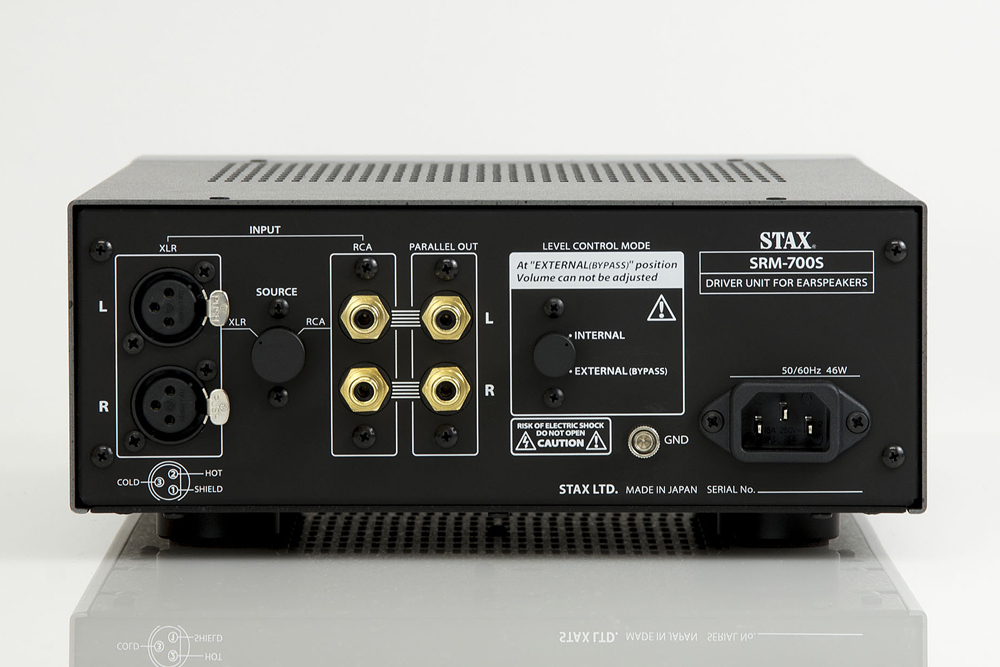
Lastly, Schubert’s String Quintet (D956), by Artemis Quartet and Truls Mørk, gave up a dirty little secret under SRM-700S’ meticulous scrutiny: one musician (a cellist, I think) tried to sneak in a quiet cough a few times, and although a faint sound like this this may be completely ignored by your speakers, such transgressions get mercilessly revealed by electrostatics!
Because of the SRM-700S’ uncompromising accuracy, you should prepare yourself to discover all sorts of issues with your recordings. After adopting electrostatic headphones I had to stop listening to a good half of the material owned due to discovering things like hissy dubbed-in passages, strange quirks in the soundstage, vocal warble and other recording goofs that speakers just don’t let you hear. After you’ve heard these deficiencies through electrostats, there’s no way back. You start recognising them when they’re played through the speakers and in all likelihood you just won’t play them anymore.
The soundstage produced by SRM-700S is expansive, precise and uncompromising. It is also completely in your head, which might require getting used to, but once you accept that you have an orchestra that’s using your cranium as a concert hall and that within that orchestra there is a crisp, assertive trumpet blowing right into your hypothalamus, you’ll just relax, enjoy the music and let worries bother someone else.
 Tube-based Stax SRM-700T
Tube-based Stax SRM-700T
In a true royal manner, SRM-700S showed no particular preference to any genre of music I threw at it. It delivered chamber orchestras with all their subtleties and details, it delivered symphonic orchestras with all their power and range, it delivered choirs with all their energy and emotion. It was superb with jazz as well as with rock and it was a particular treat to experience the delivery of Deep Purple’s “Child in time”, from Made in Japan, which made it so easy to lose yourself following every contact of drum sticks with cymbals, most prominently at the beginning of the song.
Conclusion
It’s possible that someone with a more exacting mindset and with more precisely-tuned ears than mine may discover minuscule flaws of the SRM-700S’ sound in the years to come. Right now, all I have is hints and undertones that are either not worth mentioning, or might be just figments of my imagination. Whatever it may be, this amplifier is certainly much more than just another “solid performer” like the ones that hit the market on a regular basis. The SRM-700S with electrostatic headphones leave electrodynamic headphones firmly in the dust and challenges even the best of speakers and setups with their accuracy and lifelike performance. The SRM-700S is also a convenient space-saver because for a small outlay of real estate (and a bit more of an outlay financially) you can own the pinnacle of sound reproduction that is very, very hard to better. It can reside modestly out of sight in some corner until it’s called into action, after which it becomes anything but. On the other hand, if you do put it in a prominent place and show it off, its elegance and simplicity will make sure it gets deservedly noticed.
There is one thing that SRM-700S is not suitable for. It is definitely not for people who listen to music as a background to their other activities. On the contrary, it is a true art conduit which gives you an immersive experience for which you have to sit down, close your eyes and lose yourself in the beauty of the music. Well worth the effort in my book.
Come on! Get to your nearest Hi-Fi store and admire the Stax SRM-700S. Then, try it… Just try it…
…Vedran Simunovic
www.soundstageaustralia.com
Associated & Reference Equipment
- Digital sources – Oppo BDP-105AU
- Analog source — Linn Sondek LP12, Hercules power supply, Grace 707 tonearm (modified), Dynavector 10X5,
- Preamplifier — Rotel RC-1550
- Power amplifier — Phase Linear 400 Series Two (heavily modified)
- Interconnect cables — Custom made
- Speakers — Magnepan MMG (elevated 12cm, 2 degrees off vertical)
Stax SRM-700S Electrostatic Headphone Amplifier
Price: AU$5900
Warranty: 12 Months
Australian Distributor: Audio Marketing
+61 2 9882 3877
www.audiomarketing.com.au
Stax Limited
3798-1 Shimonanbata,
Fujimi-shi, Saitama-Ken
Japan 354-0004
www.stax-international.com






